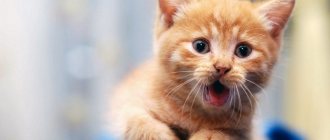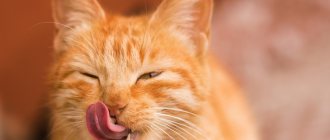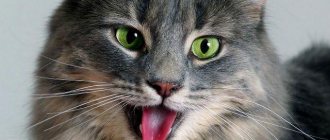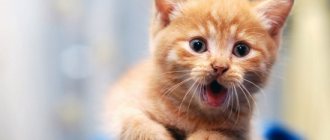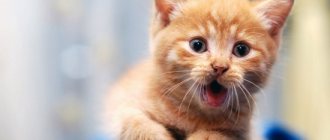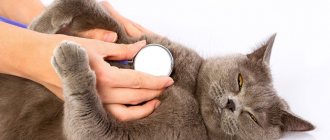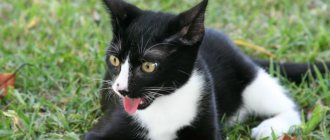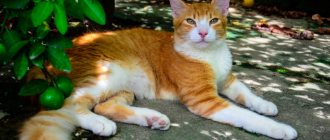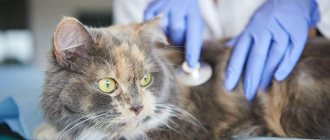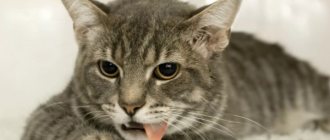Physiology of the respiratory process in cats
A kitten, like a person, differs from a dog in that it usually breathes without opening its mouth. Air enters the respiratory tract through the nose and exits the same way. Deviation from this norm is a sign of lack of oxygen. Hypoxia can be temporary and harmless. The longer this condition drags on, the more harm is done to the animal’s body. Oxygen starvation leads to disruption of the normal functioning of organs and a rapid deterioration in the pet’s health.
In a healthy animal, the space around the lungs is free, which allows this organ to easily expand, admitting inhaled air. If for some reason a malfunction occurs and the space is filled with air, the lungs are compressed and cannot gain the required volume when inhaling.
The kitten tries to compensate for the resulting oxygen deficiency by inhaling large masses of (deep) air through the mouth and sticking out its tongue. This type of breathing is called abdominal breathing, since the abdominal muscles are involved in the process. After the oxygen concentration in the circulatory system returns to normal, the animal’s condition will stabilize and the cat will again breathe through its nose as usual. In the absence of pathology in the cat's body, mouth breathing is short-term in nature and is a normal manifestation of life.
Why does a cat open his mouth?
Just because your cat's mouth is open does not mean she is mouth breathing. Make sure your cat's belly heaves when her mouth is open. They are probably mouth breathers anyway.
But sometimes a cat opens its mouth randomly, and sometimes leaves it open for a while before closing it.
Typically, when a cat leaves its mouth open, it is because it smells something interesting and is trying to get more of that smell in order to identify it. Your cat has important scent glands in her mouth, so opening her mouth helps carry scents to her most sensitive organs.
If you've ever seen a cat react to wings, where they open their mouth wide and make strange facial expressions, this is a more exaggerated form of smelling the air with these important scent glands.
© shutterstock
Causes leading to respiratory failure
Factors that cause open-mouth breathing may be physiological or pathological. Each type has its own characteristic features.
Physiological reasons
Physiological factors are not associated with deviations from the norm. Among these reasons are:
- Increased ambient temperature. Representatives of breeds with long hair especially suffer from heat.
- Excessive loads (running, jumping, playing, jogging).
- Nervous shock experienced in a stressful situation.
- Overweight.
- Hormonal releases that occur during sexual activity. An intensively working endocrine system of an animal is characterized by an increased need for oxygen.
- The process of childbirth.
Physiological factors act for a limited time. After eliminating the cause of hypoxia, normal breathing is restored. The cat owner should only wait a little until the situation stabilizes.
Pathology
Painful conditions, the symptom of which is an open mouth in a cat:
- Lesions of the oral cavity, including toothache, the appearance of ulcers on the mucous membrane, trauma, infection, cleft in the palate, etc.
- Infection of the respiratory tract by parasites.
- Foreign object in the respiratory organs.
- Diseases of the cardiovascular system (heart failure, heart disease, tumor, inflammation of the heart muscle).
- Diseases of the respiratory tract (larynx, bronchi, trachea, lungs), including edema, tumors, inflammation.
- Broken ribs. The damaged chest puts pressure on the lungs and prevents the cat from breathing normally.
- A head injury that affects the part of the brain responsible for regulating breathing.
- Damaged spinal cord.
- Intoxication.
- Allergic reaction.
- Stomach bloating.
- Torn diaphragm.
- Myopathy.
Some diseases from this group can lead to an acute lack of oxygen. The unfavorable development of such a situation is fraught with death. An owner who notices progressive difficulty breathing in a cat should immediately contact a veterinarian, especially if there are other signs indicating a serious condition of the pet.
Pulmonary edema is the accumulation of water in the lung tissues. The reasons for this phenomenon, associated with any heart disease, are called cardiogenic.
Other common reasons include:
- inhalation of hot air or steam;
- allergies of various origins (drug, food, respiratory);
- complications after pneumonia;
- asthma;
- disorders of the kidneys;
- intoxication with toxic vapors or food products;
- brain damage;
- electric shock;
- heat or sunstroke;
- sepsis.
The development of pulmonary edema occurs extremely quickly and requires urgent measures to be taken to prevent the death of the pet. A set of symptoms indicating this problem:
- weakness, apathy, indifference to what is happening;
- labored breathing;
- cough, shortness of breath, protruding tongue;
- pale bluish tint of the mucous membranes;
- pink spotting when coughing;
- rapid pulse, alternating with weakened and intermittent;
- cold extremities as a result of deteriorating blood supply.
The entry of fluid or air into the chest cavity is a consequence of traumatic injury to the muscles or ribs. Perforation, leading to the entry of atmospheric air into the chest cavity, makes it impossible to fully expand the lungs when inhaling. This condition is called pneumothorax. If the chest cavity fills with blood or other fluids circulating in the body, this is referred to as hydrothorax.
The cause of injury may be a fall from a height, a fight with an aggressive dog, or being hit by a car. An injured cat should be placed on its side, calmed down and taken to a doctor for examination. The veterinarian will be able to determine exactly how injured the pet is.
Shock is a dangerous condition that threatens with unpredictable consequences. As a result, your pet may develop an acute lack of oxygen. The causes may be trauma, intoxication, consequences of infection, allergies. The owner will not be able to bring the cat out of shock on his own; qualified medical assistance is needed. The process of bringing the animal back to normal may take more than one day.
A foreign object in the respiratory tract appears during play or eating. If a cat chokes while eating, the owner should closely monitor the pet. Usually pieces of food are coughed up without problems. If the cough lasts a long time and is accompanied by wheezing, this indicates that a foreign object has penetrated to a greater depth. To remove the object, you should immediately contact the clinic. Under no circumstances should you manipulate your cat on your own. Such a practice can lead to a sad outcome.
Cardiovascular diseases often manifest themselves as difficulty breathing. If a cat is breathing heavily and frequently after active play for a couple of minutes, this is not an alarming sign. If such a symptom occurs frequently and for no particular reason, you should have your pet examined by a feline cardiologist. An additional reason to suspect that a cat has heart failure is the bluish color of the tongue and lining of the mouth.
Breeds that are at risk for cardiac diseases are British, Scottish, Maine Coon, Sphynx, Cornish Rex, Oriental, Abyssinian. Genetic defects inherent in representatives of these breeds make these pets especially vulnerable.
Other pathologies that lead to difficulty breathing in cats:
- congenital or acquired problems with the spinal cord;
- benign or malignant brain tumor that suppresses the normal functioning of the respiratory center;
- infection with helminths that lay eggs inside the lungs;
- respiratory system diseases;
- congenital defects of the oral cavity.
Pathological causes of shortness of breath
First, we need to talk again about the hardships of pregnancy (especially in cases of large and multiple pregnancies). If there are many kittens in the uterus, or they are large, the organ increases in size very, very much. Sometimes so much so that the cat’s belly hangs almost to the ground. The swollen uterus strongly compresses not only other organs of the abdominal and pelvic cavities, but also the lungs, pressing on them from the side of the diaphragmatic dome.
Of course, this is not in vain for the organs of the respiratory system. In particularly severe cases, you may notice signs that something is wrong even during pregnancy, when the cat cannot even walk to the food bowl without immediately developing severe shortness of breath. Unfortunately, nothing can be done about this. We can only recommend maintaining optimal temperature and humidity in the room where the cat spends most of its time.
Important! Make sure that your pregnant pet does not sleep near central heating radiators. In general, given such heating, we would advise using a humidifier - with it, your pet’s overloaded respiratory system will be much easier to endure all the hardships of life.
But it’s much worse if the cat is already old. In this case, simple shortness of breath will probably not solve the problem. It's all about anatomy and physiology. If the lungs are compressed by the enlarged uterus and other organs of the abdominal and pelvic cavities, blood circulation in the pulmonary circle will be greatly hampered. This will lead to an increase in blood pressure in the vessels... of course, it cannot increase constantly. Gradually, the liquid fraction of the blood begins to seep into the alveoli of the lungs. If this phenomenon develops immediately before birth, then the animal may be lucky, and soon after the kittens are born, everything will return to normal. Otherwise, the likelihood of developing pulmonary edema is very high.
Additional symptoms
It is normal for a healthy cat to need extra oxygen after vigorous play, excitement, or hot weather. Under the influence of these factors, the cat will breathe with an open mouth for a short time. Additional signs of fatigue or agitation: raised tail, raised fur, protruding tongue. These symptoms should not cause the owner to worry.
Pathological changes in a cat’s body are necessarily accompanied by a whole complex of alarming indications. For example, problems with the heart or respiratory system will lead to a decrease in the pet’s activity, decreased appetite, and loss of interest in toys, affection and treats.
The owner of a sick cat will first of all notice that the pet is constantly lying down, has lost curiosity, and looks with a dull look. Examination of the oral cavity will show that the mucous membrane has lost its pink color and acquired a pale or even bluish tint. Breathing becomes hoarse and rapid. A constantly open mouth will indicate that the cat's condition is deteriorating. When assessing the signs, it becomes clear that the animal is close to coma and a sad end.
If there is a change in your pet's behavior, you should first look into the cat's mouth. Perhaps the furry cat is suffering from a toothache, the cat has contracted an oral infection, or has accidentally injured itself. A putrid smell often indicates advanced caries. Ulcers or rashes are a sign of infection.
If vomiting is added to breathing problems, there is reason to suspect poisoning or a gastrointestinal infection.
An accompanying symptom in the form of cough indicates problems with the respiratory system or an allergic reaction.
The owner of a furry pet should carefully monitor changes in the behavior of the ward and conduct a general analysis of the situation to determine the degree of danger. The case when a pet has difficulty breathing after active play or in hot weather is not dangerous. The presence of accompanying symptoms indicates the severity of the disease.
It is almost impossible to independently diagnose your pet correctly at home, without resorting to the help of a doctor and without conducting an examination. Therefore, if alarm signals appear, you should seek professional medical help.
Possible diseases and pathologies
When your pet snores constantly, or very often, it may be a symptom of one of the following conditions:
- swelling of the larynx; may be caused by allergies, or the presence of foreign objects in the respiratory system;
- urolithiasis disease; snoring is sometimes accompanied by wheezing;
- the presence of worms, which may even be present in the respiratory system;
- asthma;
- rhinitis;
- pneumonia and bronchitis;
- heart failure; along with wheezing, a cough and blue discoloration of the mucous membranes can be observed;
- respiratory tract infections;
- obesity.
A veterinarian will help the owner determine the cause of wheezing when breathing in a cat.
Cat breathes with open mouth in car
A cat traveling with its owners in a car may experience temporary health problems, such as shortness of breath. As a rule, this indicates that the cat is seasick. To avoid such stress, owners should think carefully about transporting their pet:
- Do not give the animal food a couple of hours before departure.
- Give your pet a drink of water before leaving and ensure access to water throughout the trip.
- If your cat begins to feel short of breath, stop briefly.
- Do not leave your cat alone in a car in a parking lot, especially in warm weather. Small animals can get heatstroke very quickly.
Providing emergency care for a pet
Every cat owner should know the list of warning signs that indicate serious problems with the animal’s health:
- Weak and lethargic appearance.
- Uncontrollable vomiting.
- Dry hacking cough or blood in the sputum.
- Anxious and fearful behavior.
Veterinarians will provide the best care to a sick cat. By trying to cope with the problem on their own, the owners of the furry patient only complicate further treatment. Heart, lung, kidney and brain diseases cannot be treated with traditional methods at home.
In an emergency situation, when the veterinary clinic is far away and you need to act quickly, you can follow the following recommendations:
- A foreign object stuck in the throat can be pulled out with tweezers or your fingers. To do this, the cat opens its mouth wide and looks into its throat. If the object is within sight, you can act.
- An object lodged across the trachea can be shaken out of the animal by grasping the cat by the hind legs and pressing on the diaphragm. If the actions are not successful, you need to urgently take the sufferer to the veterinarian.
- If the owner is sure that poisoning has occurred, before the doctor arrives, the cat should be given a weak solution of potassium permanganate to drink. Gastric lavage is the first aid for poisoning of both animals and people.
When to sound the alarm
When the above reasons for unstable breathing are absent, and the cat feels unwell, you need to pay attention to other symptoms. The presence of these deviations indicates that it is time to contact a veterinarian:
- Cough;
- Heat;
- Wheezing;
- Convulsions;
- Lack of appetite;
- Loss of appetite;
- Vomit;
- Tachycardia;
- Redness of mucous membranes;
- Nervousness or apathy.
We also recommend reading:
The largest dog breeds What is domestication in animal husbandry Why you should get a cat: reasons voiced by scientists Euthanasia of animals
Diagnostics
Difficulty breathing is a symptom of many diseases. Therefore, before making a diagnosis, the veterinarian will definitely clarify the details of the course of the disease: the duration and duration of the onset of symptoms, diet, the cat’s ability to access household chemicals and other toxic substances, and the presence of chronic diseases. After this, the doctor will examine the patient, assess the condition of the mucous membrane, touch the stomach, and count the pulse.
To make a final verdict, a hardware examination may be required: X-ray, ultrasound, ECG of the heart, rhinoscopic procedure. Even with a clear diagnosis, the veterinarian, as a rule, takes blood from the cat for general analysis and biochemical studies. Such actions are aimed at creating the most complete picture of the furry patient’s health status. Blood counts clearly demonstrate the stage of disease development and help identify pathogenic factors.
Therapy and prognosis
A set of therapeutic measures is prescribed by a veterinarian depending on the diagnosis and severity of the disease. Each disease has its own set of procedures and medications that need to be used.
First of all, medical prescriptions are aimed at saturating the body of a sick animal with oxygen. In cases of severe hypoxia, the patient is prescribed mechanical ventilation. In addition, medications are injected into the cat's blood to increase the percentage of oxygen in the blood.
The following measures are taken after receiving the results of a laboratory examination of a sick cat. Often, in order to eliminate the cause of the lack of oxygen in the body, it is necessary to use surgical treatment. Any operations, even the simplest ones, require the use of general anesthesia so that the cat, resisting the procedures, does not injure itself.
If it turns out that intoxication has occurred, measures are taken to quickly remove toxic substances from the affected cat’s body. For allergic reactions, the administration of antihistamines is required. Often, in addition to prescribing procedures and medications, the doctor adds a strict diet.
The life and speedy recovery of the furry pet depends on the timely and decisive actions of the owner. The sooner the animal receives advice from a veterinarian, the faster it will recover. Owners who expect that the cat will recover from a serious illness on its own are making an irreparable mistake. An advanced disease is more difficult and expensive to treat. A normal healthy cat breathes through its nose without opening its mouth. Any exceptions to this rule are the result of any disturbances in the functioning of the body. Temporary deviations from the standard associated with an extreme situation (childbirth, stress, heat, games) are explained by the physiology of cats and do not require medical measures. Pathological disorders are life-threatening and require immediate treatment in a veterinary clinic.
Causes of mouth breathing
The causes of heavy mouth breathing in cats due to illness are much more extensive. The main function of the respiratory system is to saturate the body with oxygen when inhaling and removing carbon dioxide when exhaling. The upper and lower respiratory tracts, lungs and respiratory muscles participate in this gas exchange.
A disruption in the functioning of any of the components leads to a malfunction in the system and oxygen starvation; in order to compensate for the lack of vital O2, the body has to change the type of breathing. Let us consider in more detail the pathologies that can cause acute respiratory failure. They are divided into two groups: the pulmonary form, which is directly related to diseases of the respiratory system, and the ventilation form, which is a gas exchange disorder caused by extrapulmonary diseases.
| The pulmonary form includes |
|
| Violation of central regulation and patency of the nerve impulse |
|
| Muscle disorders |
|
| Disorders related directly to the chest |
|
| The course of respiratory failure may be |
|
And it depends on the reasons that caused the pathology. One of the most common is pulmonary edema.
